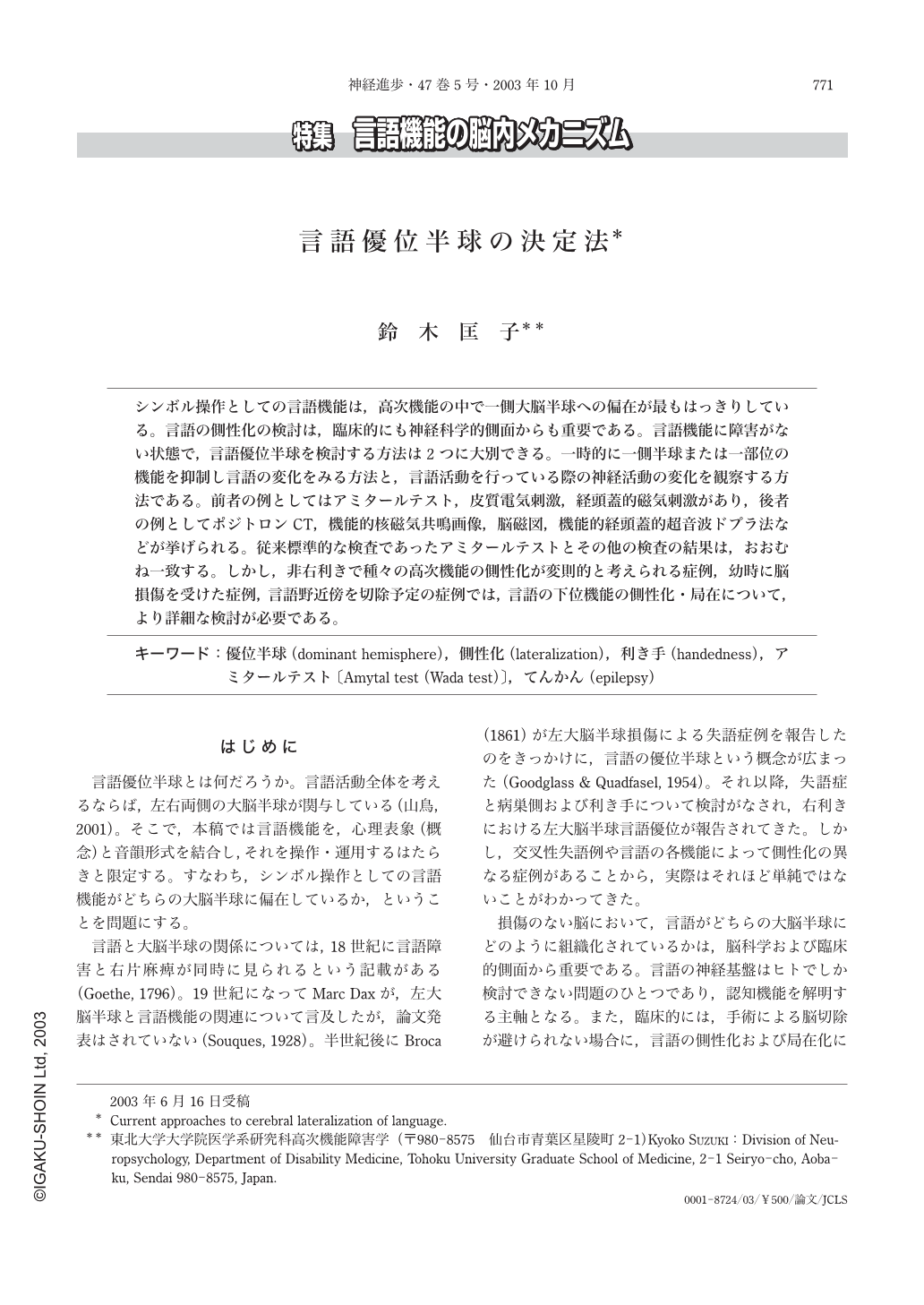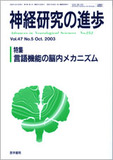Japanese
English
- 有料閲覧
- Abstract 文献概要
- 1ページ目 Look Inside
シンボル操作としての言語機能は,高次機能の中で一側大脳半球への偏在が最もはっきりしている。言語の側性化の検討は,臨床的にも神経科学的側面からも重要である。言語機能に障害がない状態で,言語優位半球を検討する方法は2つに大別できる。一時的に一側半球または一部位の機能を抑制し言語の変化をみる方法と,言語活動を行っている際の神経活動の変化を観察する方法である。前者の例としてはアミタールテスト,皮質電気刺激,経頭蓋的磁気刺激があり,後者の例としてポジトロンCT,機能的核磁気共鳴画像,脳磁図,機能的経頭蓋的超音波ドプラ法などが挙げられる。従来標準的な検査であったアミタールテストとその他の検査の結果は,おおむね一致する。しかし,非右利きで種々の高次機能の側性化が変則的と考えられる症例,幼時に脳損傷を受けた症例,言語野近傍を切除予定の症例では,言語の下位機能の側性化・局在について,より詳細な検討が必要である。
はじめに
言語優位半球とは何だろうか。言語活動全体を考えるならば,左右両側の大脳半球が関与している(山鳥,2001)。そこで,本稿では言語機能を,心理表象(概念)と音韻形式を結合し,それを操作・運用するはたらきと限定する。すなわち,シンボル操作としての言語機能がどちらの大脳半球に偏在しているか,ということを問題にする。
言語と大脳半球の関係については,18世紀に言語障害と右片麻痺が同時に見られるという記載がある(Goethe, 1796)。19世紀になってMarc Daxが,左大脳半球と言語機能の関連について言及したが,論文発表はされていない(Souques, 1928)。半世紀後にBroca(1861)が左大脳半球損傷による失語症例を報告したのをきっかけに,言語の優位半球という概念が広まった(Goodglass&Quadfasel, 1954)。それ以降,失語症と病巣側および利き手について検討がなされ,右利きにおける左大脳半球言語優位が報告されてきた。しかし,交叉性失語例や言語の各機能によって側性化の異なる症例があることから,実際はそれほど単純ではないことがわかってきた。
損傷のない脳において,言語がどちらの大脳半球にどのように組織化されているかは,脳科学および臨床的側面から重要である。言語の神経基盤はヒトでしか検討できない問題のひとつであり,認知機能を解明する主軸となる。また,臨床的には,手術による脳切除が避けられない場合に,言語の側性化および局在化に関する情報が必須となる。
本稿では,言語機能に障害がない状態で,どのようにして言語の側性化を知るかを中心に述べる。まず,利き手と言語機能の側性化の関連について検討する。さらに,言語機能の側性化や局在を,各個人で検討する方法についてまとめる。この方法は2種類に大別できる。一時的に一側半球または一部位の機能を低下させた場合の言語の変化をみる方法と,言語活動を行っている際の神経活動の変化を観察する方法である。前者の例としてはアミタールテスト,皮質電気刺激,経頭蓋的磁気刺激があり,後者の例としてポジトロンCT(PET),機能的核磁気共鳴画像(fMRI),脳磁図(MEG),機能的経頭蓋的超音波ドプラ法(fTCD)が挙げられる。最後に,言語の各機能について優位半球が異なる場合について述べる。
Many cognitive functions are lateralized to one cerebral hemisphere to a certain degree. As language is one of the most clearly lateralized functions, it is important to evaluate the lateralization of language in individual patients before surgical treatment.
The intracarotid amobarbital, or Wada test has been the standard for language lateralization. Many alternative techniques are now applied to studies on language lateralization, which are divided into two groups. The first group includes transcranial magnetic stimulation and cortical electric stimulation, which indicate language lateralization by suppressing neuronal activity on local areas and assessing the patient's ability to perform language tasks. The second group includes fMRI, PET, electroencephalography, magnetoencephalography, and functional transcranial Doppler sonography, which detect, directly or indirectly, neuronal activity associated with performance of language tasks.
Although review of the previous studies revealed that language dominance determined by the alternative techniques except electroencephalography was in fair agreement with the Wada test, the majority reported less than 100%concordance between the Wada test and the other paradigms. In addition, considerable variations were observed associated with task competence or age of disease onset. Cut-off point between left-and right-dominance was determined depending on the task and parameters in each study. Reliable distinction between patients with unilateral language dominance and those with mixed language dominance was not always possible by these methods. Considering these limitations, we cannot put sole reliance on one of these alternative techniques at present.
Combined analysis of data obtained from two or more different techniques with appropriate clinical data, such as neuropsychological tests and structural MRI, can reduce the need for the Wada test. However, the Wada test and electric cortical stimulation, both of which are invasive but more direct methods, would be necessary for patients with the possibility of atypical language dominance and candidates for resection of a region close to language areas.

Copyright © 2003, Igaku-Shoin Ltd. All rights reserved.


